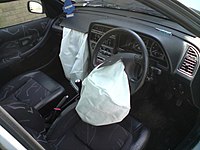
Basilar, skull and facial fractures in 2nd row occupants by crash type with a focus on side and rear impacts
Sign Up to like & getrecommendations! Published in 2022 at "Traffic Injury Prevention"
DOI: 10.1080/15389588.2022.2067330
Abstract: Abstract Objective Field data was analyzed to assess the risk of basilar, skull and facial fractures in 2nd row occupants by crash type. The study determined the rate of fractures in seriously injured (MAIS 3 + F)… read more here.
Keywords: row occupants; row; 2nd row; rear impacts ... See more keywords

Analysis of the lack of restraint with and without belt pretensioning in 40.2 km/h rear impacts
Sign Up to like & getrecommendations! Published in 2022 at "Traffic Injury Prevention"
DOI: 10.1080/15389588.2022.2121143
Abstract: Abstract Objective In rear impacts, the seat and seatbelt are intended to provide occupant restraint and maintain the occupant on the seat with favorable kinematics and low biomechanical responses. This study analyzes the lack of… read more here.
Keywords: torso; restraint; belt; lap belt ... See more keywords

Motion sequence criteria for favorable occupant kinematics in rear impacts
Sign Up to like & getrecommendations! Published in 2022 at "Traffic Injury Prevention"
DOI: 10.1080/15389588.2022.2138709
Abstract: Abstract Objective Rear-impact restraint guidelines have not developed to the same degree as for frontal crashes. This study provides criteria for favorable occupant kinematics in rear impacts. Methods Rear criteria were developed as an extension… read more here.
Keywords: kinematics; energy; kinematics rear; occupant kinematics ... See more keywords

Serious-to-fatal injury to second-row occupants in rear impacts using 1994–2020 field data
Sign Up to like & getrecommendations! Published in 2022 at "Traffic Injury Prevention"
DOI: 10.1080/15389588.2022.2140279
Abstract: Abstract Objective Serious-to-fatal injury was analyzed for second-row children aged 0–14 years and adults aged 15 and older in rear impacts by body region, restraint use, and injury mechanism using field data collected by NHTSA.… read more here.
Keywords: row occupants; rear impacts; injury; second row ... See more keywords

Quasi-static methods to evaluate seat strength in rear impacts
Sign Up to like & getrecommendations! Published in 2022 at "Traffic Injury Prevention"
DOI: 10.1080/15389588.2022.2140280
Abstract: Abstract Objective Various methods have been used in the past 50 years to apply Quasi-static load to a seat in the rear direction and measure seat performance in rear impacts. This study compared five of the… read more here.
Keywords: seat; fmvss 207; static methods; quasi static ... See more keywords

Sex, Age and Stature Affects Neck Biomechanical Responses in Frontal and Rear Impacts Assessed Using Finite Element Head and Neck Models
Sign Up to like & getrecommendations! Published in 2021 at "Frontiers in Bioengineering and Biotechnology"
DOI: 10.3389/fbioe.2021.681134
Abstract: The increased incidence of injury demonstrated in epidemiological data for the elderly population, and females compared to males, has not been fully understood in the context of the biomechanical response to impact. A contributing factor… read more here.
Keywords: head; neck; neck models; kinematics ... See more keywords